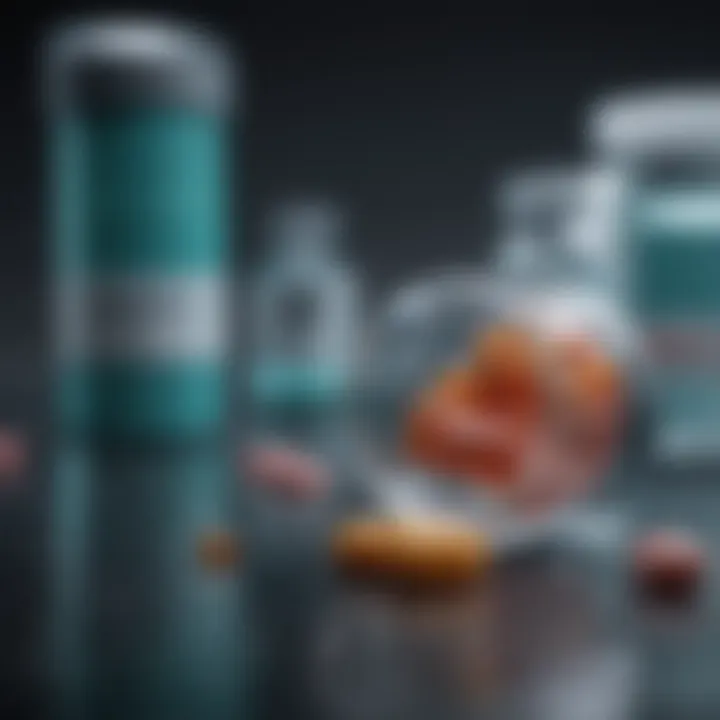Exploring Pharmaceutical Innovation: Five Pill Types


Intro
The pharmaceutical industry plays a vital role in the advancement of modern healthcare. Various forms of medication exist, and pills stand out for their wide-ranging application and delivery efficiency. Understanding the different types of pharmaceutical pills can significantly improve research, education, and patient care.
As we progress into an era of personalized medicine and advanced formulations, the need to grasp the intricacies of these pill types becomes paramount. Each category presents unique characteristics, implications, and challenges that are worthy of exploration. This article aims to provide a comprehensive overview of five key pill types shaping our current healthcare landscape.
Through methodical examination and analysis, we will provide insight into the science behind each pill category while exploring their applications, benefits, and limitations. The goal is to enhance understanding and stimulate critical thinking around pharmaceutical innovation.
Preface to Pharmaceutical Pills
Pharmaceutical pills play a crucial role in modern healthcare, serving as one of the primary forms of medication delivery. Their importance is underscored by how they bridge the gap between pharmaceutical science and patient care. Understanding various types of pills is essential for healthcare professionals, researchers, and patients alike. Each type of pill offers distinct characteristics, affecting how medications are absorbed and processed in the body.
The pills’ design is not merely a physical form, but they also embody a complex interplay of chemistry and biology. It is necessary to explore the underlying principles of each pill type to appreciate their applications in modern therapeutics. Moreover, considerations such as formulation, stability, and patient compliance directly impact the efficacy of the medication.
Key elements covered in this section
- Definition and classification of pills will illuminate the distinct categories that exist in the pharmaceutical arena.
- The historical evolution of pills provides context on how current formulations have developed over time, accompanied by advances in scientific knowledge.
The study of pharmaceutical pills is not only a reflection of historical progress but also a look towards future innovations. An in-depth understanding of these elements is essential for anyone involved in the pharmaceutical industry, especially those keen on new developments in drug delivery systems.
"Pharmaceutical innovation relies heavily on how we understand and utilize various forms of medications, primarily pills."
By examining both the definition and the historical context of pills, we can gain insight into their significance and prepare for future advancements in this critical field.
Definition and Classification of Pills
Pharmaceutical pills are solid medications designed for oral administration, typically formulated to achieve specific therapeutic effects. They can be categorized into various types based on their composition, intended use, and release mechanisms.
- Tablets: Compressed powders that may contain active ingredients along with binders, fillers, and coatings. They are widely recognized for their standardization in dosage.
- Capsules: Encapsulated powders or liquids, usually contained in a gelatin shell. They offer versatility in formulation and can mask unpleasant tastes.
- Sublingual and Buccal Tablets: Designed to dissolve under the tongue or in the cheek, allowing for rapid absorption and onset of action.
- Liquid Pills: A less traditional form, these can include syrups and emulsions, which are designed to provide alternative administration routes.
Understanding the definition and classification of these forms is fundamental in pharmaceutical sciences, as it shapes how medications are prescribed, dispensed, and consumed.
Historical Evolution of Pharmaceutical Pills
The evolution of pharmaceutical pills can be traced back to ancient times when herbal remedies were the primary form of treatment. Early approaches involved simple powders that patients would consume. The introduction of solid oral dosage forms in the 19th century marked a significant advancement.
With the advent of industrialization, pill production became mechanized, leading to more uniformity in shape and dosage. Breakthroughs in chemistry and biopharmaceuticals inspired the development of novel pill types with specified release profiles. For example, the creation of enteric-coated pills allowed medications to bypass stomach acidity and dissolve in the intestine, improving their efficacy and reducing side effects.
In recent years, research in drug delivery technologies has led to an increased focus on patient-specific formulations, including personalized medicine. This historical perspective is critical for contextualizing ongoing developments in the field today, highlighting that innovation often arises from a careful study of both past practices and current scientific inquiry.
Capsules: A Versatile Delivery Mechanism
In the realm of pharmaceutical innovation, capsules serve as a pivotal delivery mechanism. This category of pills is indispensable because of their adaptability and user-friendliness. Capsules can encapsulate various types of medication and supplements, thereby accommodating diverse therapeutic requirements. Their design allows for ease of swallowing, which is particularly significant for patients with difficulty in ingesting traditional tablets. Furthermore, the ability to mask unpleasant tastes enhances patient compliance, a critical factor in successful treatment regimens.
Types of Capsules: Hard-Shell vs. Soft-Shell
Capsules come in two primary forms: hard-shell and soft-shell. Hard-shell capsules are typically made from gelatin and consist of two parts. These capsules can be filled with powder, granules, or pellets. They are often used for formulations that require stability and controlled release. Soft-shell capsules, on the other hand, are more flexible and are usually filled with liquids, oils, or pastes. They find their application in medications that require faster absorption. Each type serves a specific purpose, and understanding these distinctions is vital for pharmaceutical formulation.
Advantages of Using Capsules
The advantages of capsules extend beyond mere convenience. They offer a wide range of benefits that are critical for both manufacturers and patients:
- Enhanced Absorption: Capsules can be designed to dissolve quickly, leading to improved bioavailability of the drug.
- Customizable Formulation: They can be easily filled with various agents without affecting stability.
- Improved Stability: Capsules can protect sensitive ingredients from environmental factors like light and moisture, preserving their efficacy.
- No Need for Coating: Unlike tablets, many capsules do not require an external coating, simplifying the production process.
Challenges in Capsule Production
Despite their benefits, capsule production is not without challenges. Several factors can complicate the manufacturing process:
- Moisture Sensitivity: Certain active ingredients may degrade when exposed to moisture, necessitating careful handling.
- Fill Material Constraints: Not all substances can be effectively placed in capsules, particularly those requiring unique handling or formulation processes.
- Quality Control: Ensuring consistent size, fill weight, and hardness requires rigorous quality control measures at multiple production stages.
- Cost Considerations: The initial costs of capsule production can be higher than those of solid dosage forms due to raw materials and technology involved.


The design and functionality of capsules contribute significantly to their role in modern pharmaceuticals. As such, ongoing innovations aim to address production challenges while enhancing therapeutic efficacy.
Understanding the nuances of capsules reveals their significance in the pharmaceutical ecosystem. Their role as a versatile delivery mechanism makes them key to pharmaceutical innovation and patient adherence.
Tablets: Standardization in Dosage Forms
Tablets are a primary dosage form in pharmaceuticals, serving as a vital means of drug delivery. Their significance lies not just in the widespread use, but also in their standardized nature. Standardization ensures that tablets are produced with consistent quality, potency, and efficacy. This is essential for patient safety and therapeutic reliability. Understanding the formulation and manufacturing process, various types of tablets, and their bioavailability marks a critical part of pharmaceutical innovation.
Formulation and Manufacturing Processes
The formulation of tablets begins with selecting active pharmaceutical ingredients (APIs) and excipients that will enhance the drug's properties. Excipients play multiple roles, such as binding agents, fillers, and disintegrants. Each component must be chosen carefully to facilitate the desired release profile and maximize efficacy.
The manufacturing process typically involves several steps:
- Blending: The API is mixed with excipients to create a uniform blend.
- Granulation: This step can either be wet or dry, aiming to improve the flow of the powder and create granules for compression.
- Compression: The granulated material is compressed into tablet form using a tablet press.
- Coating: Some tablets are coated to enhance stability or modify release.
Ensuring quality at each stage is paramount. The use of Good Manufacturing Practices (GMP) guides these processes to meet regulatory requirements.
Types of Tablets: Immediate Release vs. Extended Release
Tablets can be categorized mainly into two types based on their release characteristics: immediate release and extended release.
- Immediate Release (IR) Tablets are designed to disintegrate and release their active ingredients quickly. This is beneficial for drugs that require rapid absorption into the bloodstream.
- Extended Release (ER) Tablets are formulated to release the drug over an extended period. This can help maintain more stable drug levels in the blood, reducing the frequency of doses.
The differentiation between IR and ER tablets is critical for patient compliance and treatment efficacy. By aligning the release profile with the drug’s pharmacokinetics, healthcare providers can optimize therapeutic outcomes.
Bioavailability and Tablet Efficacy
The term "bioavailability" refers to the proportion of the administered dose of a drug that reaches systemic circulation. It is influenced by many factors, including the tablet's formulation and manufacturing.
For tablets, bioavailability can be affected by:
- The disintegration time and dissolution rate.
- The physicochemical properties of the drug, such as solubility and stability.
- The patient’s physiological factors, including pH levels and digestive health.
Understanding these dynamics is crucial. Poor bioavailability can lead to ineffectiveness, necessitating higher dosages or alternative forms of administration. Conversely, enhanced bioavailability ensures therapeutic efficiency, ultimately leading to better health outcomes.
"Standardization in tablet formulation is not just a regulatory ideal; it is a fundamental part of ensuring that patient outcomes are optimized and consistent across the board."
Overall, tablets are central to pharmaceutical innovation. Their standardization in dosage forms ensures that the benefits of medication are accessible and reliably effective, contributing significantly to public health.
Sublingual and Buccal Tablets: Rapid Absorption Methods
Sublingual and buccal tablets have gained prominence in modern medicine for their unique delivery mechanisms. Unlike traditional oral medications, these forms allow for faster absorption into the bloodstream. This section explores the underlying principles of their absorption, applications, and their comparative efficacy against traditional oral forms.
Mechanisms of Sublingual Absorption
Sublingual tablets dissolve under the tongue, allowing the medication to be absorbed directly into the vascular tissues present in that area. This method bypasses the gastrointestinal tract, where digestion and metabolism can hinder drug effectiveness. The rapid absorption occurs as the drug enters the systemic circulation almost immediately.
The key advantage here is the avoidance of first-pass metabolism, which is when the liver metabolizes a significant portion of the drug before it reaches circulation. For instances where speed is crucial, such as in emergencies, this mechanism proves invaluable. Therefore, understanding the specific requirements of solubility, stability, and bioavailability are essential in designing effective sublingual tablets.
Applications in Emergency Medicine
Sublingual tablets are particularly beneficial in emergency settings. Medications like nitroglycerin are often administered sublingually for treating acute angina pectoris. The rapid onset of these medications improves patient outcomes significantly. Other applications include narcotic treatments and anti-anxiety medications, where quick changes in drug levels are required. In these critical situations, being able to deliver a potent form quickly can be lifesaving.
Moreover, buccal tablets, which dissolve in the cheek pouch, are less frequently used, but they also offer advantages in certain cases. They are more suitable for patients who may have difficulties swallowing, such as elderly individuals or those with neurological conditions.
Comparative Analysis with Traditional Oral Forms
When contrasting sublingual and buccal tablets with traditional oral forms like standard tablets, several factors come into play. Traditional tablets require the full digestive process before the active ingredient enters the bloodstream, which can lead to a delayed response, especially in emergencies. In contrast, sublingual tablets act swiftly, resulting in nearly immediate therapeutic effects.
Key Points of Comparison:


- Onset of Action: Faster with sublingual and buccal compared to oral tablets.
- Absorption Route: Direct into systemic circulation versus gastrointestinal absorption.
- Patient Compliance: Easier for patients who have swallowing difficulties.
However, the choice between these methods depends on the nature of the drug. Not all substances are suitable for sublingual administration; they must be potent in low doses and able to dissolved effectively under the tongue.
In summary, sublingual and buccal tablets provide vital options in pharmaceutical innovation. By enabling rapid absorption, they support quicker therapeutic interventions, especially in emergency scenarios.
Liquid Pills: An Alternative to Solid Formulations
Liquid pills offer a dynamic alternative to traditional solid formulations, such as tablets and capsules. The significance of liquid pills lies in their flexibility for formulation and ease of ingestion. As healthcare evolves, these liquid formulations bring unique benefits and present challenges that need addressing.
Types of Liquid Pills: Syrups and Emulsions
Liquid pills typically consist of syrups and emulsions. Syrups are concentrated solutions of sugar in water, often flavored to improve palatability. They are mostly used to deliver medications in a sweetened liquid form, helping in cases where patients, especially children, may find solid pills challenging to swallow.
On the other hand, emulsions are mixtures of oil and water, stabilized with emulsifying agents. These are useful for delivering certain types of medications that may not dissolve well in water alone. Both types of liquid pills serve to enhance the bioavailability of the active ingredients, thus improving therapeutic outcomes.
Benefits of Liquid Formulations
There are several key benefits associated with liquid formulations. Firstly, they tend to offer faster absorption rates compared to solid forms. This is particularly advantageous in emergency situations where rapid onset of action is required. Furthermore, liquid pills can be adjusted for dosage more easily, allowing for more personalized treatment regimens.
Additionally, liquid formulations can mask the unpleasant tastes of drugs, significantly enhancing patient compliance. The ability to deliver a wide range of active ingredients also extends to varying demographics, including pediatric and geriatric populations, who may struggle with solid forms.
Stability and Shelf Life Concerns
While liquid pills have their merits, they are not without drawbacks. Stability is a major concern for liquid formulations. They may be prone to degradation over time, particularly in the presence of heat and light. This degradation can impact the effectiveness of the medication.
Moreover, shelf life is shorter for many liquid pills when compared to their solid counterparts. Manufacturers often need to implement preservatives or specialized packaging to mitigate these issues. Therefore, it is imperative to carefully monitor the stability of liquid formulations throughout their production and storage processes.
"Liquid pills provide a viable alternative to traditional formulations, capturing the essence of modern pharmaceutical innovation."
Interpreting the role of liquid pills within the context of pharmaceutical development reveals both their promising advantages and notable challenges. Overall, understanding these components is crucial as the industry navigates toward more responsive and effective drug delivery mechanisms.
Innovations in Pill Technology
The advancement of pharmaceutical pills is closely tied to innovations in technology. The landscape of drug delivery and formulation is in constant evolution, driven by the need to improve patient outcomes and streamline healthcare processes. Innovations in pill technology encompasses various aspects, such as enhanced patient compliance, improved drug efficacy, and the integration of digital health solutions. This section will explore two critical innovations: smart pills and nanotechnology. Each presents unique advantages and potential challenges for the future of medicine.
Smart Pills and Digital Health Integration
Smart pills are a significant breakthrough in the pharmaceutical industry. These are oral medications that incorporate digital components, enabling them to transmit data to healthcare providers or patients. The technology behind smart pills often includes sensors and ingestible electronics that monitor adherence, dosage timing, and even physiological markers.
The main benefits of smart pills lie in their potential to improve patient compliance. When patients can receive reminders about their medication schedules through apps or alert systems, adherence rates can increase. Furthermore, real-time data collection allows healthcare providers to track treatment effects and adjust therapies accordingly.
"Smart pills represent a marriage between pharmacology and technology, opening new avenues for chronic disease management."
However, significant challenges remain. Issues of privacy and data security are paramount, as patient information is transmitted and stored digitally. Additionally, the production of these pills requires a seamless integration of pharmacological components and digital technology, which can be complex and costly.
Nanotechnology in Pill Development
Nanotechnology refers to the manipulation of matter on an atomic or molecular scale, typically below 100 nanometers. In pill development, this technology is used to enhance solubility, stability, and bioavailability of drugs. By altering the physicochemical properties of drugs at the nanoscale, pharmaceutical scientists can develop more effective medication formulations.
One prominent application of nanotechnology is in the creation of nanoparticles. These can be used to deliver drugs more efficiently to targeted areas in the body, maximizing therapeutic effects while minimizing side effects. This precision in targeting is especially beneficial in cancer therapies, where delivering a drug directly to tumor cells can improve efficacy and reduce collateral damage to healthy tissues.
However, as with smart pills, there are obstacles. The long-term effects of nanoparticles on human health are still not fully understood. Rigorous testing is required to ensure the safety and efficacy of these advanced formulations before they can achieve widespread clinical use.
Regulatory Considerations for Pill Production
The pharmaceutical industry operates under stringent regulations that ensure the safety, efficacy, and quality of medications. Regulatory considerations for pill production are critical to maintaining public health and trust in pharmaceutical products. Understanding these regulations informs various stakeholders, including manufacturers, healthcare professionals, and patients, about the standards that govern pill formulation and distribution.
Compliance with regulatory frameworks mitigates risks associated with unsafe or ineffective medications. In the United States, the Food and Drug Administration (FDA) plays a pivotal role in monitoring and regulating pharmaceutical products. These guidelines are essential for maintaining high-quality production that meets health standards.
FDA Guidelines and Approval Processes


The FDA establishes specific guidelines for the research, development, and approval of pharmaceutical pills. Before a pill can enter the consumer market, it must undergo a rigorous testing process. This process is divided into several phases:
- Preclinical Testing: This initial phase involves laboratory studies and animal testing to evaluate safety and biological activity.
- Investigational New Drug Application (IND): If preclinical results are favorable, an IND application must be submitted to the FDA. This document provides data from preclinical studies and outlines the proposed clinical trials.
- Clinical Trials: These trials occur in three stages:
- New Drug Application (NDA): If clinical trials demonstrate that the drug is effective and safe, an NDA is submitted. This application includes all data collected during drug development.
- Post-Market Surveillance: After approval, ongoing monitoring of the drug is critical to ensure long-term safety and efficacy.
- Phase 1: Tests safety and dosage in a small group of healthy volunteers.
- Phase 2: Focuses on effectiveness and side effects, usually in a larger group of patients.
- Phase 3: Conducted on large populations to confirm effectiveness and monitor adverse reactions.
These steps are paramount for building trust among healthcare providers and patients. They provide a framework for clinicians prescribing these medications and for consumers seeking safe options for their health.
Quality Control Measures
Quality control in pill production ensures that each batch of medication meets strict standards before reaching the market. Several key measures are essential for maintaining quality in pharmaceutical manufacturing:
- Good Manufacturing Practices (GMP): Compliance with GMP guidelines is mandatory. This set of regulations ensures that products are produced consistently and controlled to quality standards.
- Batch Testing: Every batch of pills is subject to testing for potency, purity, and contamination. This ensures that every pill contains the correct dosage and is free from harmful substances.
- Stability Testing: Stability studies determine the shelf life of a drug. It assesses how the drug's composition changes over time under various storage conditions.
- Documentation: Comprehensive records must be kept throughout the production process. This includes detailed logs of raw materials, production methods, quality control tests, and any deviations from established protocols.
"Quality in pharmaceuticals is not merely desirable; it is imperative for patient safety and therapeutic success."
In essence, adherence to these quality control measures not only supports regulatory compliance but ultimately safeguards public health. Manufacturers must remain vigilant and proactive, ensuring that the processes in place unequivocally uphold the commitments to safety, efficacy, and reliability in pharmaceuticals.
Philosophical and Ethical Implications of Pill Consumption
The philosophical and ethical implications of pill consumption are profound areas of consideration. These aspects go beyond mere biochemical interactions and touch upon the trust between healthcare providers and patients. Understanding these implications is essential in ensuring that pharmaceutical innovations are not only effective but also embraced by the public. The following sections will delve into key considerations related to patient compliance and access to pharmaceuticals, fostering a deeper understanding of their significance within the broader healthcare landscape.
Patient Compliance and the Role of Trust
Patient compliance is a critical factor in the success of any treatment regimen. When patients trust their healthcare providers, they are more likely to adhere to prescribed therapies. Trust can be influenced by several factors: the effectiveness of the medication, the physician's communication skills, and the perceived integrity of pharmaceutical companies. When patients feel they have been accurately informed about the benefits and potential risks of the pills, they are often more committed to their treatment plans. Trust builds confidence, reducing anxiety around medication intake, especially in cases where side effects or complex dosing regimens are involved.
Moreover, the digital era has introduced new dimensions to this trust. Patients often have access to extensive information about their medications online. They may seek advice from forums or social media platforms like Facebook and Reddit. Thus, the role of digital health literacy becomes crucial. Encouraging patients to engage with credible sources when seeking information about their medications can enhance their confidence and understanding.
In this context, it is imperative for pharmaceutical companies to maintain transparency in their communications. Clear labeling, accessible drug information, and responsiveness to patient inquiries foster a sense of accountability. This trust directly influences compliance, ultimately impacting health outcomes.
Access and Equity in Pharmaceutical Distribution
Access to pharmaceuticals is not uniform across all demographics. Various factors, including socioeconomic status, geography, and governmental policies, affect how individuals secure necessary medications. The implications of this disparity are far-reaching. Disparities in access contribute to health inequities, which is an ethical concern that needs addressing.
Pharmaceutical companies have a responsibility to consider ethical distribution practices. Pricing strategies must be evaluated to ensure that essential medications remain accessible to those in need. This calls for the development of fair pricing models. Similarly, efforts to provide medications in underserved areas must be prioritized. Innovative distribution channels, such as partnerships with local health organizations, can enhance accessibility for populations with limited resources.
Ensuring equitable access to pharmaceuticals is not just a market consideration; it is a moral obligation that underscores the very principles of healthcare as a right rather than a privilege.
The collaboration between governments, healthcare providers, and pharmaceutical companies is crucial in creating a more equitable distribution landscape. Universal access to essential medications should be a collective goal within the industry to prevent unnecessary suffering and enhance overall public health.
End: The Future of Pharmaceutical Pills
The exploration of pharmaceutical pills is essential to comprehend how modern medicine evolves in response to patient needs and technological advances. The future of these formulations promises significant developments shaped by innovative trends and healthcare demands.
Pharmaceutical pills are no longer just traditional methods of drug delivery. They are transforming into complex systems that consider patient compliance, pharmacokinetics, and targeted therapies. Understanding the emerging trends in pill development is crucial for various stakeholders including researchers, practitioners, and policymakers, as they navigate the evolving landscape of healthcare.
Emerging Trends in Pill Development
The emergence of technology in pill development showcases a range of possibilities. Innovations like smart pills and nanotechnology are setting new benchmarks. Smart pills can track patient compliance and provide real-time data, contributing to personalized medicine. By integrating digital health features, these pills can communicate with healthcare providers, improving treatment outcomes.
Moreover, nanotechnology is paving the way for more effective and efficient drug delivery. It enhances bioavailability and ensures that medicines reach their intended targets with increased precision. Pharmaceutical companies are investing in research to develop pills that can adapt to various biological environments, which promises more effective treatments.
Key trends to watch include:
- Development of biosimilar pills that imitate original branded drugs
- Enhanced formulation technologies for better absorption
- Increased focus on patient-centric designs
- Integration of blockchain for supply chain transparency and safety
Long-Term Implications for Healthcare
The advancements in pharmaceutical pills are poised to influence long-term healthcare strategies. As the healthcare landscape evolves, treatments will become more individualized, reducing the one-size-fits-all approach. By targeting specific patient profiles, the effectiveness of medications can greatly improve, leading to higher patient satisfaction and compliance rates.
Additionally, the implications extend to cost-effectiveness in healthcare. With better-targeted therapies, there is potential for reduced hospital admissions and lower treatment costs in the long run. Improved medications can lead to faster recovery and minimize the need for additional interventions.
However, challenges persist. Regulatory bodies must keep pace with innovation to ensure safety and efficacy of new products. Proper evaluation and oversight will be essential to maintain public trust in pharmaceutical advancements. As the industry continues to push boundaries, ongoing dialogue about access, quality, and equity in the distribution of these advanced pills will be paramount.
"The future of pharmaceutical pills is not just about innovations, but also about creating equitable access to these advancements for all populations."
In summary, understanding the future trends and implications of pharmaceutical pills is critical for anyone involved in healthcare. This includes students, researchers, regulators, and practitioners who must align with the changing dynamics of the field. The integration of cutting-edge technology and a focus on patient-centric care will play a key role in how medications are developed and consumed moving forward.







